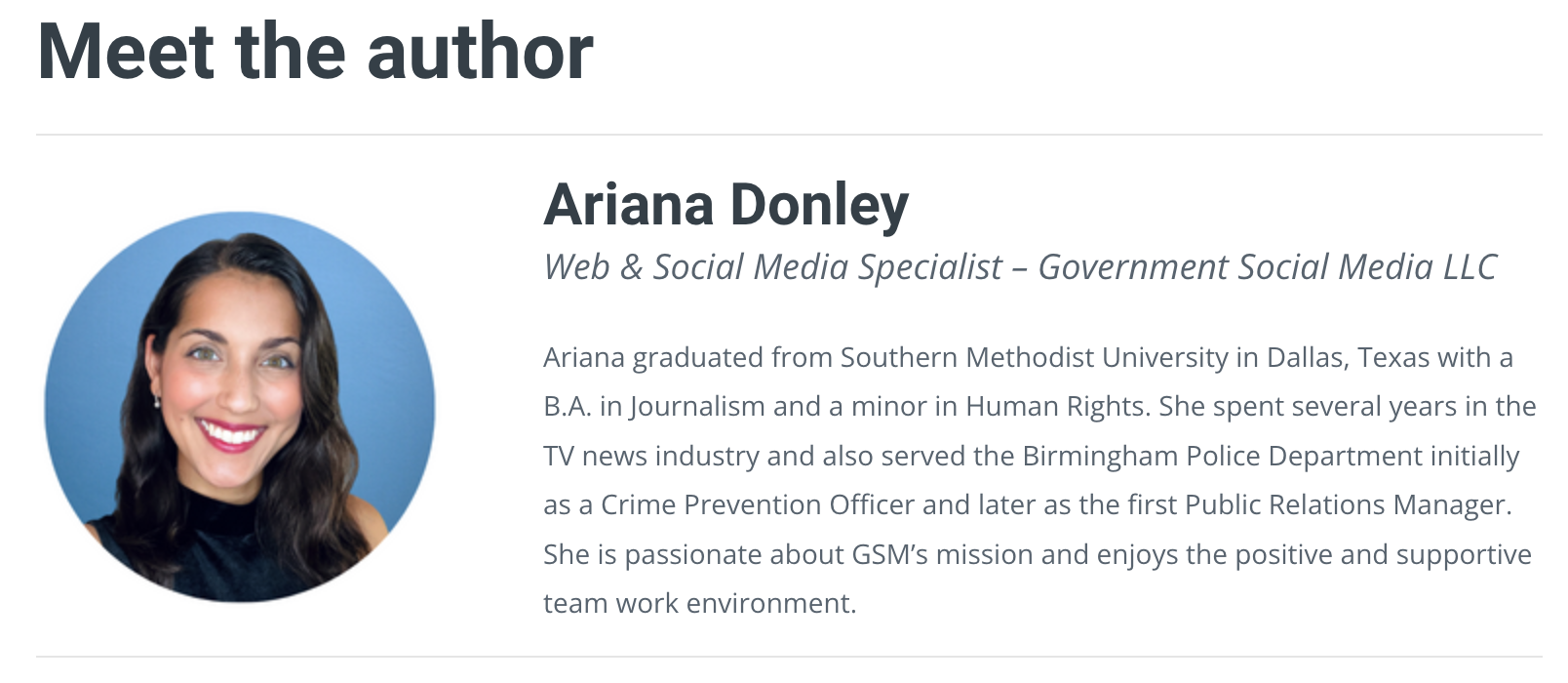
Guide: Prepping your agency’s social media for crisis
May 11, 2022Contributed blog by Ariana Donley, Web & Social Media Specialist at Government Social Media
As a government social media professional, sharing life-saving safety information to help your community prepare for Mother Nature’s catastrophic events is, well, second nature.
National Hurricane Preparedness Week was the first full week of May and National Wildfire Preparedness Month runs through the end of May. So, let’s explore ways you can prepare yourself and your agency’s social media for the moments when keeping the public informed is critical.
Inter-agency relationships matter
Develop good working relationships with the emergency managers in your community. Not only will this help you during a crisis, it can also help you stay abreast of potential dangers and provide you with unique preparedness and prevention ideas to add to your content calendar. Additionally, maintaining a solid relationship could help you produce top tier content that has the visual or audio support you may not otherwise have access to — especially on a deadline.
It’s also important to invest time in getting to know the PIOs and social media managers for other first responder agencies, such as police and fire, in your area. These professionals can help you identify safe staging areas during a crisis and keep you informed of secondary threats, such as blocked roadways, and efforts underway to resolve dangerous situations.
Don’t overlook coordination with your 911 call centers who are on the frontlines of each and every crisis and can help inform you about the nature of top calls for service and what campaigns, if any, could reduce the volume of non-emergency calls.
Tips on building relationships from a former journalist
Believe it or not, I used to absolutely dread making phone calls to set up interviews during my early days as a news reporter — even for straight-forward and non-controversial stories. Taking the next step to put myself out there in order to build sources, earn and protect their trust was downright intimidating.
Once you start, it gets easier. Here are some lessons I learned:
- First and foremost: Treat everyone with respect and kindness – not just the people you hope to connect with. No job title is more important than another and everyone matters.
- Keep business cards handy and be generous with them. Word doesn’t only travel fast online – it also travels fast in the real world. The more people who get to know you and what you do, the better.
- Be seen and heard. Attending an event to snap photos? Plan on also taking some time to introduce yourself to people you don’t already know and revisit familiar faces. Talk with your supervisor about scheduling time to visit different departments or events to network. Send an email to people you’d like to connect with to schedule a time for a visit.
- Take a genuine interest in the people around you and the people you want to meet. While it’s true that a crisis can help form bonds, it’s better to invest in relationships ahead of time so that you’ll know who to go to in an urgent situation and those people will already know your work ethic and what to expect from you.
- Match their energy. Not everyone likes socializing and that’s totally OK. If you feel someone isn’t in the mood to talk, be respectful and move on. Others may be extremely chatty and share information about their personal lives. If you don’t feel comfortable doing the same, don’t, but be respectful.
- It’s a cliche — but there really is no such thing as a stupid question. As a social media professional, having even a basic understanding of many things can help you in countless ways — from content inspiration to managing comments and DMs. Inquiring about aspects of someone’s job and duties can help you better understand not only their operations but also what motivates them and your interest will no doubt be noticed and likely appreciated.
- Don’t be afraid to ask for help. If you’re ever in a tight spot and don’t know where to turn for information, having a wide network to rely on can help point you in the right direction.
- Be honest and transparent. Ever been “voluntold” to do something you don’t agree with or understand how to do? We’ve all been there. Explain that you’re just carrying out the task assigned to you.
- Extend invites. Have time to grab lunch or coffee? Invite others to join you or rideshare to meetings or events, if you feel comfortable. Some people prefer alone time, so don’t take it personally if they turn you down.
- Be professional, always. Just as being a socialgov comes with unique challenges, you never know what someone else is dealing with professionally or personally. Make your best effort to be on time to meetings and events. Appear attentive during meetings — both in person and virtually. Avoid shoptalk and gossip.
Stay in your lane
While cultivating inter-agency relationships is key, you don’t want to overstep your purview. It's great to be proactive, but knowing when to defer to another agency for their specialized advice is important, too. For example, information on the safest place in your home to shelter from a hurricane may be better coming from an agency with experts on the matter. You can always share or retweet their content on your accounts to make sure your audience has access to this credible information.
While staying in your lane will likely be appreciated by those around you, don’t mistake that for taking a backseat. Trust your gut, your experience and your position. Social media should never be an afterthought. If social media is not already a consideration ahead of major events or potential crisis, talk to your supervisor about getting you a seat at the table and explain it’s in the best interest of your agency and the public.
Be prepared to share reasons why, which include (but are not limited to):
- Education: To quickly disseminate safety and prevention information in your agency’s own words before and during a crisis as well as information about wraparound services in the aftermath.
- Addressing misinformation: Possibly the only thing that travels as fast — or possibly even more quickly — than a wildfire is misinformation on social media. When social media is an integral part of your agency’s crisis communications, you can help mitigate the spread.
- Monitoring: To gather real-time updates during a crisis
- Building trust: To show the public they can rely on your agency to guide them during a crisis and in the future
Additionally, having the ability to share information as local alerts on social media is a major asset. If you’re not familiar with how to do so, check out our guide to local alerts.
Understand your audience
When trying to raise awareness of a potential crisis or educate your community about general preparedness, consider what type of content has performed best for your audience on each platform. Knowing what kind of content has the highest reach and/or engagement can help your content reach more people and potentially save more lives.
As Twitter’s Lauren Devoll advised during a keynote session at the 2022 Government Social Media Conference, joining a conversation is easier than starting one. So don’t be afraid to join conversations relating to hurricane or wildfire preparedness and threats relevant to your geographic location. This can be an opportunity to share helpful information about storm shelters, rescue efforts, donation drives, or any other initiatives that your agency promotes with a wider audience.
Prepare resources in advance
Don’t wait for a threat to form — or become a reality — to come up with a game plan for any visuals or graphic designs you’ll need for your agency’s social media accounts. Developing thoughtful visual templates in advance can help your content stand out and encourage people to stop scrolling and give your content a serious look.
It’s no secret that Canva is a popular graphics site for socialgovs. As Anndrea Harris, social media and marketing specialist for the City of Wichita Falls, TX, pointed out in her breakout session at GSMCON2022, setting up a brand kit can do wonders for your content and save you time when every second counts. Having an established brand kit will make it easy to add your agency’s logo, approved colors and fonts to your designs.
Keep in mind, graphics may not be the best mode of communication for everyone. There are likely people in your community who are unable to view visuals the way you intended, which is why accessibility should be a forethought and not an afterthought as you plan content. If you’re not familiar with how to incorporate accessibility into your agency’s social media, there are three simple ways to help you get started with making your social media accessible.
Additionally, be aware of what languages are spoken in your community. If your agency doesn’t have a translator to help you build graphics or facilitate live events, now is the time to network with local organizations that can help so you’re not scrambling during a crisis.
Finally, be realistic
If you’re in a time crunch or lack support to create additional content, sharing social media updates from your local emergency management agencies, police or fire departments can be a great asset. Keep in mind, you can also take advantage of efforts from larger agencies by amplifying their posts relevant to your community or sharing their free, pre-produced social media toolkits.
- Ready.Gov
- National Oceanic and Atmospheric Administration
- National Weather Service
- U.S. Fire Administration
As a socialgov, you know that anything and everything can go wrong on a normal day – not to mention during a crisis. Consult this SocialGov Crisis Checklist for more considerations to make as you prepare.

Best communicate with the public you serve by becoming a part of the free Government Social Media network — only available to full/part-time employees of government or educational institutions.
We support the largest network of government social media professionals in the U.S. by guiding government agencies through complex social media issues. Government Social Media helps you successfully communicate with the public you serve, protect your agency and keep public trust while finding your support community.
Government Social Media® empowers government professionals to achieve mastery in social media through conferences, online training, and association membership. Best communicate with the public you serve and get connected with fellow socialgovs by registering for the 2025 Government Social Media Conference happening in the Orlando-area and virtually from wherever you are! Join the free GSM Network for text-only chats on socialgov topics or access the Government Social Media Association (GSMA) for regional virtual meetups and educational webinars.









